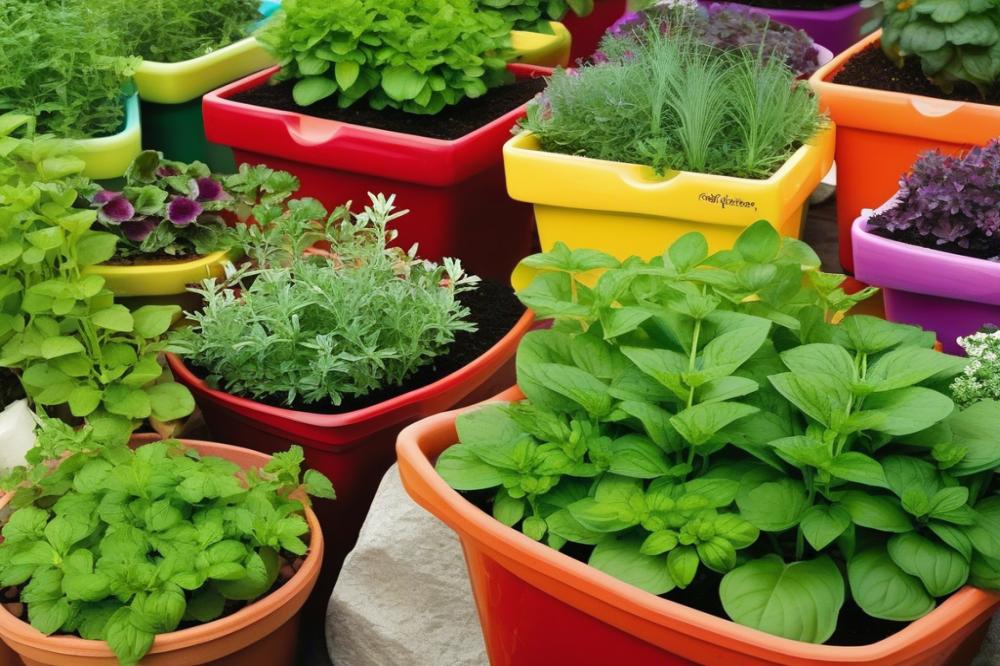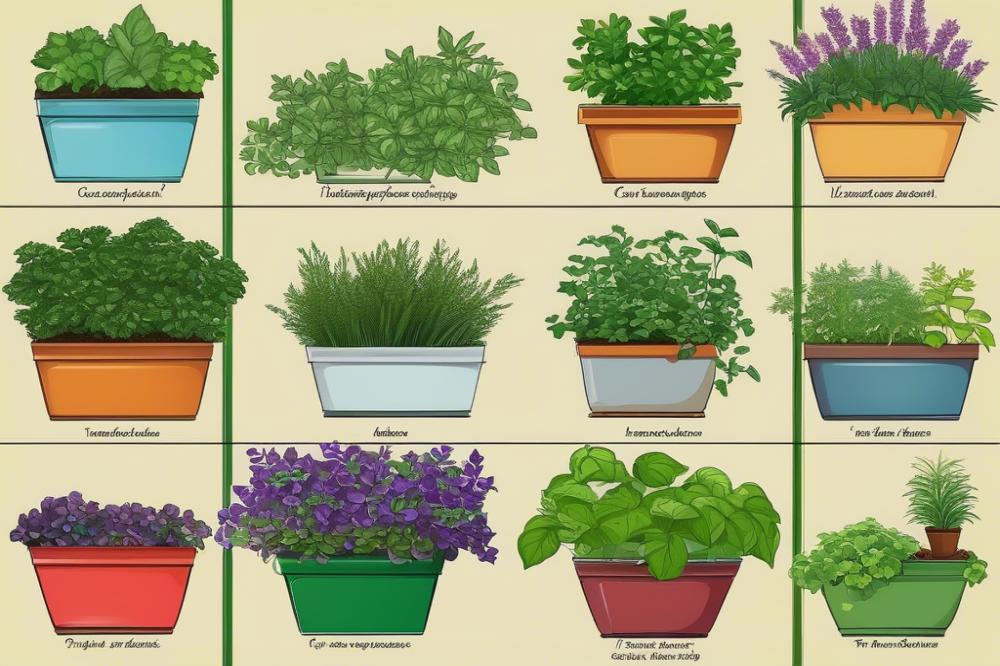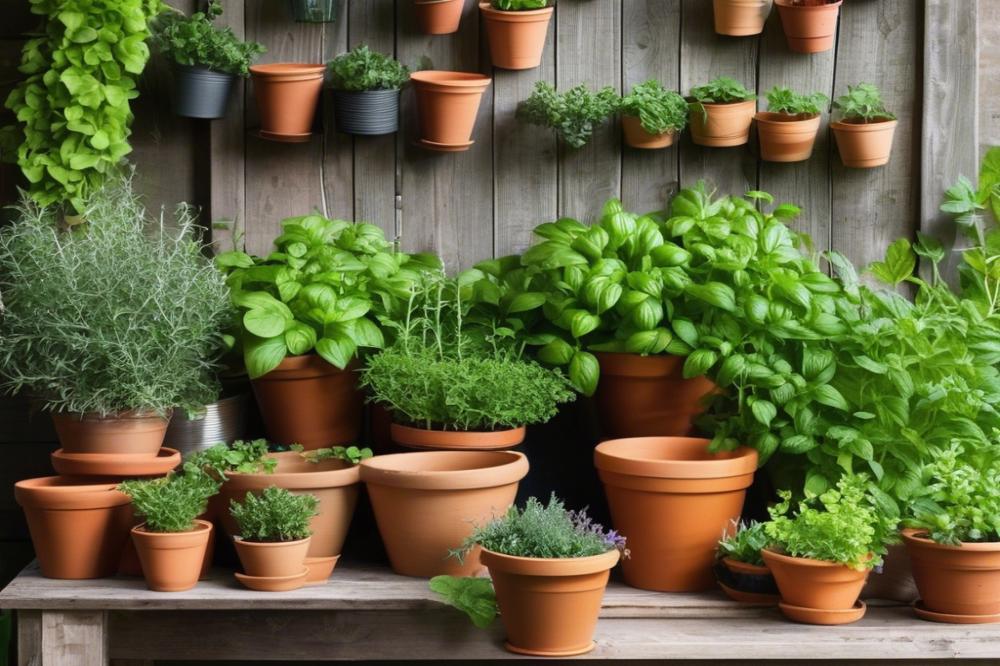Tips for Growing Herbs in Containers
Growing plants in pots or other types of containers has become increasingly popular, especially for those with limited space. Container gardening allows you to cultivate a variety of plants, including flowers and vegetables, wherever you have room. The process can be rewarding and enjoyable, providing fresh greenery right at your doorstep. With just a little effort and attention, anyone can create a thriving garden in small spaces.
Herbs are particularly valuable for those who enjoy cooking. Fresh herbs can elevate a dish, adding flavor and aroma that dried versions cannot match. Cultivating your own organic herbs means you have easy access to the freshest ingredients. This is especially great for home cooks who understand the difference a fresh basil or cilantro can make in a meal.
Planting herbs in containers offers the flexibility to grow them both indoors and outdoors. Whether you want to place pots on a sunny windowsill or set them on a patio, adaptability is a significant advantage.gardening“> indoor gardening allows for enjoyment year-round, regardless of seasonal changes. However, taking care of these plants requires attention to light and water needs.
Maintaining an outdoor herb garden has its own challenges and rewards. You must consider factors such as drainage, sunlight requirements, and the right potting soil. A well-draining potting mix is essential for healthy plant growth. Water needs will vary between types of herbs, so understanding what each variety requires is crucial. Seasonal herbs will thrive at different times of the year, making it important to know when to plant each type.
As you embark on this journey, remember that herb maintenance is key to success. With proper care, your container herbs will flourish, providing you with fresh flavors right from your garden.
Choosing the Right Containers


When starting your herb garden, picking the right container can make all the difference. Containers need to be of suitable size. Each herb has different root depth and growth habits. Too small a pot can stunt the plant’s growth. Larger pots may retain too much moisture, which isn’t ideal for all herbs.
Material also plays a key role in your choice. Clay pots are great for enhancing drainage. They allow air to circulate through the soil, promoting healthier root systems. Plastic containers can be lighter and easier to move. However, they may not provide as much breathability, thus requiring extra attention to herb maintenance.
The Importance of Drainage in Containers
One critical factor to consider is drainage. Herbs do not like to sit in water. Too much moisture can lead to root rot. Therefore, always select pots with drainage holes at the bottom. If you find a pot that you love but has no holes, don’t hesitate to create some yourself.
Using potting soil suitable for herbs will also aid in drainage. Many potting mixes are designed to improve airflow while retaining the right amount of moisture. As you grow your plants, always monitor the soil’s moisture level. Over-watering can quickly kill even the healthiest looking herbs.
Best Practices for Indoor vs Outdoor Containers
Indoor gardening presents unique challenges. Herbs in your home may not get enough natural light. Consequently, consider using grow lights to provide adequate sunlight requirements. Placing your containers near a window can also help. Keep in mind that indoor herbs might require more consistent watering due to the drier air often found indoors.
In contrast, outdoor containers benefit from natural weather patterns. Be sure to check the plants regularly to adjust your watering based on seasonal change. Temperature and humidity can vary significantly, affecting water needs. Choosing the right location outside is vital as well; some herbs thrive in full sun while others prefer partial shade.
Selecting the Right Herbs


Growing herbs can be a delightful addition to your gardening efforts. Choosing the right types for your container is essential. Some herbs thrive in pots, making them a perfect fit for any garden, especially for indoor gardening or outdoor containers.
Top Herbs to Grow in Containers
When selecting herbs for your pots, consider popular options like basil, cilantro, and parsley. These herbs are versatile, adding flavor to many dishes. Thyme and oregano are also excellent choices. They require less maintenance and will flourish with the right care.
Differentiating Between Seasonal Herbs and Perennial Options
Understanding the difference between seasonal and perennial herbs will help you make an informed decision. Seasonal herbs, such as dill and basil, typically grow well in warm months. By contrast, perennial herbs like mint and chives can survive through different seasons, regrowing year after year.
Choosing Organic Herbs for Better Flavor and Health Benefits
Opting for organic herbs is a smart choice. These options often boast superior flavor without harmful chemicals. Consider the water needs and sunlight requirements for your selected herbs. Potting soil should be rich and well-draining to promote healthy growth. Monitor your plants regularly for signs of stress, and maintain consistency in herb maintenance. This attention will reward you with a bountiful harvest of fresh flavors.
Optimal Potting Soil and Drainage


Choosing high-quality potting soil is essential for a successful herb garden. This soil is designed specifically for container gardening. Unlike garden soil, potting soil has the right mix of components to support healthy growth. A good option will retain moisture while allowing excess water to escape. Healthy herbs thrive when their roots can breathe.
Drainage is a significant factor in plant care. Herbs do not like soggy conditions that occur if water cannot flow freely. One way to boost drainage is by adding materials like perlite or vermiculite to your potting mix. These light ingredients help create air pockets and allow water to move. Additionally, consider using pots with holes at the bottom. Without proper drainage, your herb maintenance will be challenging.
Mixing Soil for Healthy Herb Growth
Creating the right soil mix is crucial for growing strong plants. A simple recipe includes equal parts potting soil, compost, and sand. Compost provides nutrients while sand enhances drainage. While mixing, try to maintain an airy texture. Organic herbs benefit from such a well-balanced foundation.
Always check the water needs of your specific herbs. Some plants prefer a drier environment, while others thrive with more moisture. Adjust your soil mix accordingly, especially if you’re growing seasonal herbs. Sunlight requirements matter too. Place your containers where they can get the necessary light, which can affect soil moisture levels. Remember, a well-prepared soil mix sets the stage for vibrant growth.
Sunlight Requirements for container herbs


Understanding Sunlight Needs of Various Herbs
Different herbs have specific sunlight needs. Basil and parsley thrive in full sunlight, while mint prefers partial shade. Each type of herb will benefit from receiving at least six hours of sunlight daily. When planning your garden, think about the light that each herb requires. Some seasonal herbs can adapt to less light, but most organic herbs will flourish with ample exposure. Knowing these differences helps you choose which herbs to plant together in your outdoor containers.
Strategies for Positioning Containers for Optimal Sunlight
Proper placement of your herb containers is key. Placing them on a balcony or near a sunny window can work well. Using rolling plant stands can provide flexibility in moving pots to catch the best light during the day. Position containers away from any structures that may block sunlight. Facing your pots south or southwest often maximizes sunlight exposure. Regularly check your plants to see if they’re reaching toward light; this can indicate they need a better spot.
Considerations for Indoor Herb Gardening Regarding Light
Indoor gardening presents unique challenges. Natural light may be limited in some homes, especially during winter months. Consider using fluorescent or LED grow lights to supplement the natural light your herbs receive. Placing your containers near bright windows can help, but make sure not to crowd them. Herbs still need space to breathe and grow. Adjust the height of your lights and pots to mimic a more natural daylight cycle. Proper drainage and high-quality potting soil will also support your herbs’ health indoors.
Water Needs and Maintenance
Guidelines for Watering Container Herbs
Watering is crucial for growing herbs in containers. Start by using potting soil that retains moisture but also allows excess water to drain. Each herb has its own water needs, so it’s wise to research the specific varieties you are growing. Monitor the moisture level by touching the soil an inch below the surface. The top layer may look dry, but the root zone might still be damp. Water in the early morning or late afternoon to minimize evaporation. Indoor gardening often requires more frequent checks since the air inside tends to be drier.
Signs of Overwatering or Underwatering
Observing your plants will reveal their health. Leaves turning yellow can indicate overwatering, while wilting leaves might signal underwatering. Those with soggy soil often suffer from root rot. Conversely, leaves that are crispy or browning at the tips suggest a lack of water. Check the drainage holes in pots; water should freely escape. Make sure the container has enough drainage to prevent water from pooling. If your herbs frequently show stress, consider adjusting your watering habits.
Herb Maintenance Tips for Healthy Growth
Regular maintenance leads to thriving plants. Pruning is essential for many species, helping to promote bushier growth. Seasonal herbs benefit greatly from this practice. Fertilizing can also enhance their health and yield. Choose organic herbs if you are concerned about chemicals in your garden. Always follow the guidelines for sunlight requirements, as proper lighting fosters lush growth. Rotate pots occasionally to ensure even sunlight exposure. Pay close attention to pest problems, as they can quickly take over if not managed. Keeping a close eye on all aspects of your garden will pay off in flavorful herbs.
Pest and Disease Management in Container Gardening
Common Pests Affecting Container Herbs
Container gardening can attract various pests. Aphids are tiny and often found on new growth. They can suck the sap and weaken your plants. Spider mites create webs and can cause leaf damage. Whiteflies may also appear, especially in warmer weather. Each of these pests can affect growth and overall health. Recognizing the signs is the first step in protecting your plants. Damaged leaves or discolored foliage may indicate a pest problem.
Natural Methods for Pest Control
Using natural methods can be effective for managing pests. Soap sprays can help eliminate aphids without harming the plant. Mix a few drops of dish soap with water, and spray it on affected leaves. Neem oil is another natural solution. It disrupts the lifecycle of many insects and can help reduce their numbers. Introducing beneficial insects can also aid in pest control. Ladybugs, for example, will feast on aphids and other pests. Regular checks will assist in catching problems early. Keeping your pots clean can prevent pests from settling in as well.
Preventive Measures for Disease in Container Gardens
Focusing on prevention can keep diseases at bay. Selecting the right potting soil is crucial for healthy growth. Well-draining soil helps prevent root rot and other moisture-related issues. Make sure pots have adequate drainage holes. This helps excess water escape, reducing the risk of disease. Choosing the proper plants is another factor. Some herbs are more resistant to diseases than others. Regularly inspecting your plants will allow you to spot early signs of stress. Proper spacing can also enhance airflow, promoting healthy growth. Remember to follow good plant care practices like watering according to each plant’s needs.
Harvesting and Using Your Container Herbs
Best Practices for Harvesting to Promote Growth
Harvesting herbs correctly is vital for their continued health. Always use sharp scissors or pruning shears to make clean cuts. When cutting, take only a third of the plant at a time. This practice avoids over-harvesting and allows the herb to recover quickly. Focus on snipping leaves and stems from the top, which encourages bushier growth. Keeping your herbs trimmed also prevents flowering too early, which can change their flavor.
Monitoring growth and timing your harvest is crucial. Wait until the herbs are well established. This generally means waiting a few weeks after planting in well-drained pots filled with quality potting soil. Seasonal herbs, like basil and oregano, respond well to regular harvests, so use them often. If you think it’s time to re-pot, do it in spring or fall for the best results.
Ways to Use Herbs in Cooking and Preservation Methods
Cooking with herbs adds fresh flavor to meals. Chopped basil can elevate a simple pasta dish. Rosemary pairs wonderfully with roasted meats. Experimenting in the kitchen could also lead to discovering your unique favorite combinations. To preserve herbs, consider drying or freezing them. They retain flavor when frozen in ice cube trays with water or oil.
You might also want to create your own herb-infused oils. Simply fill a jar with herbs and cover them with olive oil. Let it sit for a couple of weeks in a cool, dark place. This method enhances flavors and works well for cooking.
Encouraging Continuous Growth Through Proper Harvesting
Proper maintenance contributes to the longevity of your herbs. After each harvest, observe the health of each plant. Regularly check for signs of pests or diseases. Maintaining optimal sunlight requirements and water needs is essential. Herbs like garlic chives thrive in bright light, while others, such as parsley, prefer partial shade.
Water thoroughly but allow for proper drainage to prevent rot. This consideration is critical, especially in outdoor containers. Use organic substances whenever possible. This method promotes healthy growth and enriches the soil naturally. Building a routine for care will boost your success. Remember, a little effort goes a long way in the world of indoor gardening. Plant care is not just about the harvest. It’s about a consistent commitment to growth.
Final Thoughts on Growing Home Herbs
Growing herbs in containers brings a special joy to any gardening enthusiast. Fresh flavors, vibrant colors, and delightful aromas can enliven your meals and brighten your space. First of all, starting with simple varieties like basil, parsley, and mint can help build confidence. Each herb offers its own unique taste, adding a rich layer to your culinary dishes.
Consider the benefits of having these plants right at your fingertips. When you need a sprig of rosemary or a handful of cilantro, they are merely steps away. No need to rush to the store when a dish calls for fresh herbs. Plus, the act of nurturing these plants can be incredibly rewarding. It encourages mindfulness and patience as you engage in plant care.
Try your hand at indoor gardening if you have limited outdoor space. Even a sunny windowsill can host a mini herb garden. It does not take much to get started. Basic supplies such as pots, soil, and seeds are enough to lead you on a fulfilling journey. As you gain experience, feel free to experiment with more diverse varieties.
Always remember that the freshness of home-grown herbs enhances flavors like nothing else. They can transform simple dishes into unforgettable ones. The satisfaction of harvesting your own ingredients is unmatched. So, why wait? Dive into the world of container gardening. With some basic care and dedication, you will soon enjoy the many benefits that home-grown herbs can provide.



